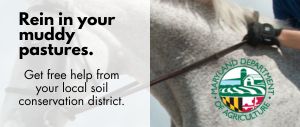first published in the April 2024 Equiery
Maryland is home to over 100 public parks that offer equestrian-use trails. We have parks in every county across the state, and trail riding adventures abound for all levels of riders, from coastal vistas to mountain passes. These parks are managed and maintained by state and county resources, but they need our help to keep them in good shape.
Trail users, whether on foot, bike or horseback, have a duty to protect these trails if we want them to remain open for generations to come. Here are a few tips on how horseback riders can be trail stewards while enjoying a lovely ride.
• Ride on Dry Trails – Rainfall tends to be heaviest in the spring here in Maryland and when it rains, the quality and stability of trails can suffer. The same can be said for heavy snowfall as it melts during winter months. A general guideline is to stay off trails for 24 hours per inch of rainfall. Riding through areas of wet soil can create muddy areas that end up holding water long after the rain has stopped or the snow has melted.
• Stay on the Path – It may seem like a simple request, but it is a vital one! Stay on trails designated specifically for horses. Trail blazing can create soil erosion or damage wildlife areas meant to be bypassed. In addition, trails are marked for use by park officials and often there is a safety reason behind a trail not being designated for horses. In addition, riding in a single file line on trails helps reduce trail damage.
• Educate Before You Ride – Be sure to scope out the trail system before you start your ride. Most parks have online maps and all will have posted maps near the entrance of the park, if not at every major trail head. Planning your route ahead of time will help prevent overuse of heavily trafficked trails. Also be sure to find out if there are any trail closures before you head out and be sure to respect trail closure signs.
• Clean Up – Although picking up manure dropped on the actual trails may not always be possible, cleaning up after your horse in parking lots and along roads is. If the park you are riding in does not have a designated manure disposal area, pack it in your trailer and dispose of it at home. Also, keeping your horse moving while it poops on a trail will naturally spread out the manure. Cleaning up after yourself and your horse applies to trash too! Littering comes with substantial fines in most parks.
• Small Groups – It may be fun to get a large group of friends together for one massive group ride, however the more horses traveling the same trail at the same time, the more damage each footfall creates. Riding in small groups lessens the impact on the trail surface.
• Slow Down – A leisurely walking trail ride has less impact on the trail surface then a high-speed gallop. Plus, walking allows you to enjoy the scenery longer and chat with friends along the way. For the safety of other trail users, horseback riders should always slow to a walk when passing hikers, mountain bikers or park vehicles.
• Waterways – Some trail systems have access to watering areas where you can allow your horse to drink or take a cooling dip. Be sure to only access water through designated paths and never ride up or down embankments along waterways. Doing so not only puts you and your horse at risk for falling, but also creates erosion areas and damages vegetation holding embankments in place.
• Share the Trails – Every public park in Maryland that offers equestrian-use trails also opens those trails to hikers, and often mountain bikers as well. The “right of way” for multi-use trails is that bikers yield to hikers and horses while hikers yield to horses. Technically, horseback riders have the right of way on multi-use trails, however it is our job as riders to represent the community well. The Maryland Horse Council has long supported the shared use of our natural resources, so “peaceful coexistence” is our goal. Be kind to those you meet on the trail. You never know, you might be their first introduction to the horse community!
• Volunteer – The best way to ensure healthy trails is to help maintain them! Contact your local park officials or trail group and find out when trail clearing days are scheduled. Or even better, get permission from park officials to organize a trail clearing day of your own!
This article was compiled from TROT, Extension Foundation and AQHA.












